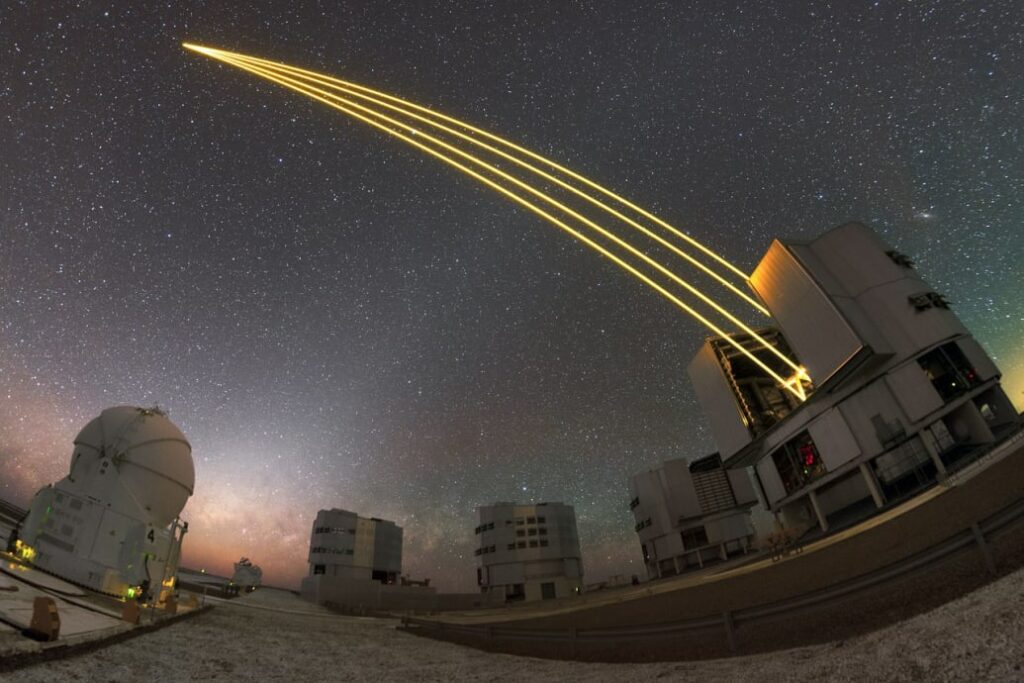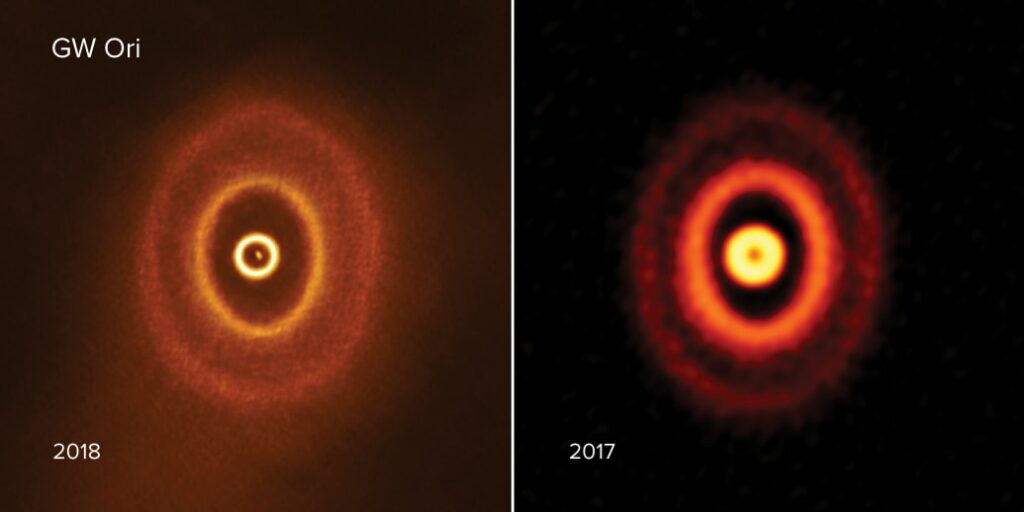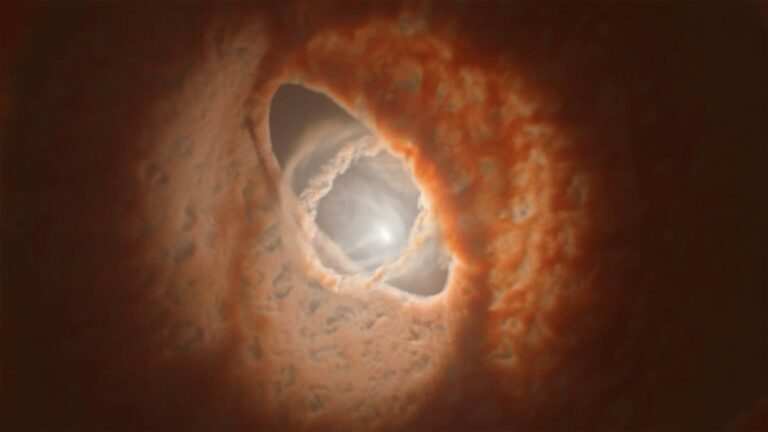A Triple-Star System Is Either Hiding a Planet, or Defying the Laws of Physics
GW Orionis might be a revelation for how planets are formed—if it’s actually home to one.
Space is full of weird stuff, but more than 1,300 light-years from Earth, there’s a star system called GW Orionis that makes a lot of other bizarre phenomena seem outright dull.
For starters, GW Orionis has three stars rather than the usual one. Two orbit each other, and the third orbits the pair. Already we’re in territory stranger than Star Wars.
And that’s not all. The three stars with their clockwork orbits are surrounded by three rings of dust and gas. Such rings—called “protoplanetary disks,” since they possess the building blocks of larger objects like planets and moons—are common.
What’s uncommon is the orientation of GW Orionis’s disks. They’re misaligned, like a stack of plates with pebbles wedged between them. They are, in astronomical parlance, “torn.”
The disk-tearing is so strange that the only way astronomers who study GW Orionis can make sense of it all is to imagine there’s a giant planet there in the dust and gas, adding its own gravity to the mix.
The problem is, there’s no hard evidence the triple star system is home to any such planet. None. Zero. Zilch.
Taken together, the three stars, the wobbly disks and the unseen planet combine to make GW Orionis one of the oddest star systems on record.
Solving the mystery behind how GW Orionis is physically constructed isn’t just a niche, one-time puzzle. It would also tell us more about the fundamental processes behind the formation of all planets, including our own.
Down the Cosmic Rabbit Hole
Astronomers first spotted GW Orionis back in the 1940s. But it wasn’t until 1991 that a bright-eyed generation of new stargazers, staring through powerful telescopes, began to suspect that there was more than one star in the system.
It took another 20 years of study for astronomers to conclude there were three stars in GW Orionis and a protoplanetary disk surrounding all of them. That’s when the discoveries began to really pile up—and it became clearer just how strange GW Orionis really is.
Three-star systems are uncommon, but not rare. NASA estimates that around 10 percent of the roughly 7 billion star systems in our galaxy have three stars. What is rare is for a triple-star system to also have protoplanetary disks.
Things only got weirder from there. In 2017, Stefan Kraus, an astronomer at the University of Exeter in the United Kingdom, and his colleagues got a close look at GW Orionis using the Atacama Large Millimeter/submillimeter Array and the European Southern Observatory’s Very Large Telescope, both in northern Chile. They found the system’s disks are misaligned and torn, publishing their findings in Science in September 2020.
A year later, a team led by Jeremy Smallwood at the University of Nevada published a study in Monthly Notices of the Royal Astronomical Society that tried, for the first time, to simulate GW Orionis’ torn disks in order to explain them. What they think is happening is that at least one very massive planet is hiding somewhere in GW Orionis’ rings.

One of the unit telescopes of the Very Large Telescope in Chile.
If so, it would be the very first planet we’ve found in a “circumtriple orbit,” meaning it circles around three stars.
A few weeks later in the The Astrophysical Journal Letters, a team led by Jiaqing Bi at the University of Victoria in Canada, followed up to the work that Smallwood’s crew began. Bi’s group estimated the size and mass of GW Orionis’ rings and concluded that the outermost ring, 31 billion miles from the center of the system, is the biggest protoplanetary disk ever recorded, with the same mass as 245 Earths. “The three dust rings have enough solids to make many cores of giant planets,” they wrote.
Like Smallwood’s team, Bi’s team concluded that the stars alone shouldn’t tear the three disks. “Therefore, this hints at some other mechanism,” they wrote.
“One of the most exciting hypotheses,” Bi and his colleagues added, “is that [the tears] are produced by embedded companions ranging from stellar-mass all the way to super-Earths.” In other words, there is likely a very big planet—maybe more—sitting in the dust and stirring things up.
Finding a huge planet, or two, or three in the dust and gas around a messy, complex three-star system would be a profound discovery. “If planets can form around three stars, that means planet formation is a lot more robust than we once thought,” Smallwood told The Daily Beast.
And if planet-formation really is that robust, we might expect to find planets in stranger and stranger places as we get better at looking.
There are signs that’s already happening. A team led by Iain McDonald, an astronomer at the University of Manchester in the United Kingdom, tapped data from a now-defunct NASA space telescope and spotted what they believe are a handful of cold, dark, free-floating planets that don’t orbit any star. The astronomers described their study in the August issue of Monthly Notices of the Royal Astronomical Society.
Big Planet, Big Doubts
Finding a planet around GW Orionis might explain the system’s torn disks while also jibing with our expanding notion of what, and where, planets even are. But Smallwood and Bi and the others are just assuming there’s a planet around GW Orionis. No one has a shred of evidence that any planet is actually there.
And that’s not all that surprising. No telescope can see far enough, with enough fidelity, to make out a planet—even a big one—in dust 1,300 light-years from Earth. “The study on the possible planet may only be on the simulation level,” Bi told The Daily Beast.
Nader Haghighipour, a planetary dynamicist at the University of Hawaii-Manoa, objects to the planet assumption. It reflects a bad astronomical habit, he told The Daily Beast. Ever since the first planet outside our solar system was discovered, “when people got stuck explaining a phenomenon, they threw a planet at it,” he said. It’s become a kind of an analytical Band-Aid for covering an incomplete understanding of the cosmos.
The practice has become so widespread in astronomy that according to Haghighipour, it has inspired a cliche: “Can’t explain it, say there is a planet in it.”

The problem is that “no one, absolutely no one, ever worries whether that planet can actually form there,” Haghighipour said. In his view, GW Orionis is too unstable to develop a planet—a process that takes many millions of years. Smallwood’s and Bi’s studies are not rigorous science: “What they have done stays at the level of an idea,” Haghighipour said.
But Smallwood and Bi defend their work. Smallwood said GW Orionis’ suitability for planet-formation was outside the scope of his research anyway; he and his team were just trying to determine whether GW Orionis’ stars alone can account for the system’s weird disks.
And Bi added that GW Orionis should theoretically be able to form a planet, so it’s reasonable to simulate it as having one. “Assuming a planet in the GW Orionis disk is at least not wrong.”
This debate won’t be resolved until someone takes a hard, close look at GW Orionis and determines if there’s a planet there. Only then can we say for sure whether the weird, three-star system with its uneven rings is proof that planets can form almost anywhere—or only in calm, stable environments.
But that won’t be possible until we have much better telescopes, Bi said. “We are looking forward to seeing the answer… in the future.”
In the meantime, some scientists studying GW Orionis might just keep guessing.
This article was originally published by TheDailyBeast. Read the original article.
Do not forget to share your opinion with us to provide you with the best posts !




0 Comments